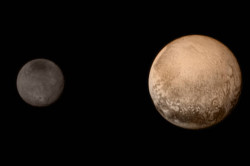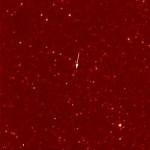Pluto, Charon portrait
 The team puts together a photo from New Horizons LORRI and RALPH showing a portrait of Pluto and Charon as the probe makes its final approach.
The team puts together a photo from New Horizons LORRI and RALPH showing a portrait of Pluto and Charon as the probe makes its final approach.
First signs of Pluto’s geological features
 New Horizons takes this photo 5.4 million km (3.3 million miles) from Pluto which starts to show distinct geological features on the surface.
New Horizons takes this photo 5.4 million km (3.3 million miles) from Pluto which starts to show distinct geological features on the surface.
We’re close enough now that we’re just starting to see Pluto’s geology. Among the structures tentatively identified in this new image are what appear to be polygonal features; a complex band of terrain stretching east-northeast across the planet, approximately 1,000 miles long; and a complex region where bright terrains meet the dark terrains of the whale.
Discovers heart-shaped region
The probe discovers a heart-shaped region on Pluto:
https://twitter.com/NewHorizons2015/status/619081578602479616
Over the next week the spacecraft will be just 7,750 miles away from the dwarf planet. Team member:
The next time we see this part of Pluto at closest approach, a portion of this region will be imaged at about 500 times better resolution than we see today. It will be incredible.
Pluto map
 NASA releases this map compiled from photos taken between June 27 and July 3 showing the following features along the equator: The long dark area on the left, named “the whale” measures 3,000 km (1,800 miles), above the whale’s tail is a doughnut shaped area measuring 350km (200 miles) across, to the right of the whale’s head is the brightest region, and further to the right are four mysterious dark spots.
NASA releases this map compiled from photos taken between June 27 and July 3 showing the following features along the equator: The long dark area on the left, named “the whale” measures 3,000 km (1,800 miles), above the whale’s tail is a doughnut shaped area measuring 350km (200 miles) across, to the right of the whale’s head is the brightest region, and further to the right are four mysterious dark spots.
Pluto is red-brown
 New Horizons’ RALPH instrument confirms that Pluto is reddish brown probably caused by hydrocarbon molecules that are formed when cosmic rays and solar ultraviolet light interact with methane in its atmosphere and on its surface.
New Horizons’ RALPH instrument confirms that Pluto is reddish brown probably caused by hydrocarbon molecules that are formed when cosmic rays and solar ultraviolet light interact with methane in its atmosphere and on its surface.
Pluto’s reddish color has been known for decades, but New Horizons is now allowing us to correlate the color of different places on the surface with their geology and soon, with their compositions. This will make it possible to build sophisticated computer models to understand how Pluto has evolved to its current appearance.
Path clear
 After a detailed search for dust clouds, rings, and other potential hazards, the New Horizons team decides the spacecraft will remain on its original path through the Pluto system instead of making a late course correction to detour around any hazards. Because the probe is traveling at 49,600 km/h (30,800 mph), a particle as small as a grain of rice could be lethal.
After a detailed search for dust clouds, rings, and other potential hazards, the New Horizons team decides the spacecraft will remain on its original path through the Pluto system instead of making a late course correction to detour around any hazards. Because the probe is traveling at 49,600 km/h (30,800 mph), a particle as small as a grain of rice could be lethal.
We’re breathing a collective sigh of relief knowing that the way appears to be clear. The science payoff will be richer as we gather data from the optimal flight path, as opposed to having to conduct observations from one of the back-up trajectories
Two faces of Pluto
 NASA releases photos that show Pluto’s two different faces. The right photo shows a series of four evenly spaced dark spots along the equator. The left photo shows the hemisphere the probe will view as it flies by.
NASA releases photos that show Pluto’s two different faces. The right photo shows a series of four evenly spaced dark spots along the equator. The left photo shows the hemisphere the probe will view as it flies by.
It’s a real puzzle—we don’t know what the spots are, and we can’t wait to find out.
Speeds up
New Horizons fires its thrusters for 23 seconds speeding up about a half mile per hour in order to perfect its course through the Pluto system. Without the adjustment, the probe would have arrived 20 seconds late and 114 miles (184 kilometers) off-target from the spot where it will measure the properties of Pluto’s atmosphere. Those measurements depend on radio signals being sent from Earth to New Horizons at precise times as the spacecraft flies through the shadows of Pluto and Pluto’s largest moon, Charon. The probe is 16 million km (10 million miles) from the Pluto system and about 4.75 billion km (2.95 billion miles) from Earth.
This maneuver was perfectly performed by the spacecraft and its operations team. Now we’re set to fly right down the middle of the optimal approach corridor.
More terrain revealed
 NASA releases a series of photos of Pluto as the New Horizons probe approaches. The close approach hemisphere that the probe will pass by shows the greatest variation in surface features. The probe is 4.7 billion km (2.9 billion miles) from Earth and just 25 million km (16 million miles) from Pluto.
NASA releases a series of photos of Pluto as the New Horizons probe approaches. The close approach hemisphere that the probe will pass by shows the greatest variation in surface features. The probe is 4.7 billion km (2.9 billion miles) from Earth and just 25 million km (16 million miles) from Pluto.
This system is just amazing. The science team is just ecstatic with what we see on Pluto’s close approach hemisphere: Every terrain type we see on the planet—including both the brightest and darkest surface areas —are represented there, it’s a wonderland!
Pluto’s different features
 NASA releases a series of photos as the New Horizons probe approaches showing areas of intermediate brightness and also very bright and very dark surface features. The probe is 4.7 billion km (2.9 billion miles) from Earth and 39 million km (24 million miles) from Pluto.
NASA releases a series of photos as the New Horizons probe approaches showing areas of intermediate brightness and also very bright and very dark surface features. The probe is 4.7 billion km (2.9 billion miles) from Earth and 39 million km (24 million miles) from Pluto.
Even though the latest images were made from more than 30 million miles away, they show an increasingly complex surface with clear evidence of discrete equatorial bright and dark regions—some that may also have variations in brightness. We can also see that every face of Pluto is different and that Pluto’s northern hemisphere displays substantial dark terrains, though both Pluto’s darkest and its brightest known terrain units are just south of, or on, its equator. Why this is so is an emerging puzzle.
Jupiter gravity boost
 New Horizons makes its closest approach to Jupiter at a distance of 2.3 million km (1.4 million miles) passing through an aim point just 500 miles across in order to get a gravity assist that will boost its speed toward Pluto. The probe gains almost 14,000 km/h (9,000 mph) accelerating to over 83,600 km/h (52,000 mph). It has traveled 800 million km (500 million miles).
New Horizons makes its closest approach to Jupiter at a distance of 2.3 million km (1.4 million miles) passing through an aim point just 500 miles across in order to get a gravity assist that will boost its speed toward Pluto. The probe gains almost 14,000 km/h (9,000 mph) accelerating to over 83,600 km/h (52,000 mph). It has traveled 800 million km (500 million miles).
We’re on our way to Pluto. The swingby was a success; the spacecraft is on course and performed just as we expected.
Sees Pluto
 The Long Range Reconnaissance Imager (LORRI) takes its first photos of Pluto from 4.2 billion km (2.6 billion miles) away. At this distance Pluto is just a faint point of light among the stars.
The Long Range Reconnaissance Imager (LORRI) takes its first photos of Pluto from 4.2 billion km (2.6 billion miles) away. At this distance Pluto is just a faint point of light among the stars.
Finding Pluto in this dense star field really was like trying to find a needle in a haystack. LORRI passed this test with flying colors, because Pluto’s signal was clearly detected at 30 to 40 times the noise level in the images.
Third course correction
The probe fires its thrusters again for 76 seconds in order to perfect its path toward Jupiter. It is 51.7 million km (32.1 million miles) from Earth traveling at 37.5 km (23.3 miles) per second.
Second course correction
New Horizons fires its thrusters for twelve minutes to refine its trajectory toward Jupiter. It is 11.9 million km (7.4 million miles) from Earth.
Everything performed as planned. New Horizons has to fly through a precise aim point near Jupiter to get to Pluto on time and on target, and these maneuvers are putting us on the right path.
Course correction
New Horizons performs its first trajectory correction maneuver by firing its thrusters for four minutes 36 seconds to begin bringing it on a path to rendezvous with Jupiter where it will get a gravity assist to speed it on its way to Pluto.
Launch successful
The Atlas V rocket with the New Horizons probe is launched successfully. After 44 minutes and 53 seconds it separates from its solid-fuel kick motor. Five minutes later mission control receives the first signals from the probe that all is well. The fastest probe ever launched is hurtling through space at 36,000 mph on its three billion journey to Pluto. NASA:
Today, NASA began an unprecedented journey of exploration to the ninth planet in the solar system. Right now, what we know about Pluto could be written on the back of a postage stamp. After this mission, we’ll be able to fill textbooks with new information.
Probe shipped
John Hopkins University Applied Physics Laboratory, which built the New Horizons probe, ships it to NASA Goddard Space Flight Center for its next round of pre-launch testing. APL Project manager:
Our testing program is off to a good start. We’ve shown that New Horizons is structurally ready for the ride on the launch vehicle, and now we’ll test it in the full range of conditions it would face on the voyage to Pluto, Pluto’s moon, Charon, and beyond.
Funding approved
After a hard political battle, President Bush signs an omnibus bill which includes $110 million in initial funding for NASA’s New Horizons mission to Pluto and the Kuiper Belt System. The funding allows the team to proceed with the final design of the probe.
It’s like the old days. We are going to the frontier. We’re going back to the roots of the space program.
Faster arrival
As the New Horizons team studies the mission and their launch window, they realize that they can get the probe to Pluto a year earlier than anticipated.
This [is] a great opportunity to improve our scientific return while reducing mission risks and costs. We’ll get a better look at Pluto itself, since more of the surface will be sunlit and the atmosphere will be another year away from freezing onto the planet’s surface. We’ll have more fuel for the journey into the Kuiper Belt after exploring Pluto-Charon, and the shorter cruise time reduces some of the costs associated with flight operations.
Mission approved
NASA selects the New Horizons proposal from Southwest Research Institute for a mission to Pluto and the Kuiper Belt System. Director of SRI space studies:
We’ll be exploring frontier worlds near the edge of the planetary system. This mission is likely to rewrite textbooks regarding the origin of the planets, the nature of the outer solar system, and even the origin of primitive materials that may have played a role in the development of life.
